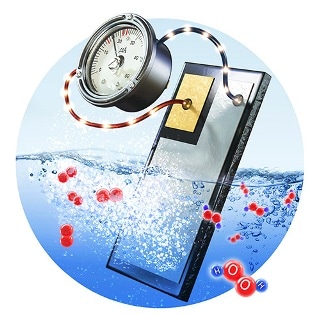Jul 14 2016
As seen in diverse applications, such as the refinement of petrol, their use in batteries and fuel cells for electric cars and to aid in the cleanup of hazardous agricultural waste, a variety of catalysts are in constant development to fulfill economic and environmental demands. To maximize the catalytic reaction, a great deal of research effort is made to reveal its mechanism. As a key to understanding catalysis, hot electrons are of great interest in the field.
 The IBS team's front cover from Angewandte Chemie. (Credit: Institute for Basic Science (IBS))
The IBS team's front cover from Angewandte Chemie. (Credit: Institute for Basic Science (IBS))
The IBS team led by group leader PARK Jeong Young, reported the direct detection of hot electrons generated at a solid-liquid interface during an exothermic reaction on the surface of metal-semiconductor nanodiodes. This is the first time a research team has succeeded in detecting hot electrons in a liquid interface.
In general, hot electrons gain very high kinetic energy from external energy sources such as electromagnetic radiation or an exothermic chemical reaction. They are created in the course of the chemical reactions and can be detected using a catalytic nanodiode consisting of a thin film of a catalytic metal deposited onto a semiconductor support. As the metal thickness is smaller than the electron mean-free path, hot electrons can reach the metal–semiconductor boundary without significant attenuation and generate an electric current, known as the chemicurrent.
The research team confirmed the first observation of the hot electrons through the exothermic catalytic reaction occurring at the liquid phase. Previous findings were limited to observing hot electrons in gas-solid interfaces which diluted their generation efficiency; the atomic density of liquid is 1000 times higher than that of gas (1 atmospheric pressure).
The study has long-reaching implications for the commercial use of implementing hot electrons as catalysts. Corresponding author Professor Park explained: "Hot electrons are the key element in the fundamental understanding of catalysis. This finding may lead to highly efficient catalytic devices, which will allow for diverse applications in liquid phase such as a fuel cell and artificial photosynthesis."
The team found that catalytic decomposition of hydrogen peroxide (H2O2) on varied metal catalysts exhibits the hot electron flows up to 10-1 electrons per product molecule, which is much higher than previously published data for solid-gas reactions on similar nanodiodes. According to their manuscript, published online on July 4 in Angewandte Chemie, and selected as the featured cover story, "the possibility of detecting hot electrons generated by non-adiabatic energy dissipation can be also used with other exothermic reactions at the liquid–metal interface. Remarkably, the chemicurrent allows the surface reaction and the state of the catalyst to be monitored in real time."
Park stressed "Many electron-based techniques of surface science are only capable of operating in a vacuum or at low gas pressures. Since this study enables to trigger both the creation and detection of chemicurrent inside the nanodiode, our approach is not limited to specific environmental conditions.”
Thus, this provides a highly sensitive and powerful tool for studying the processes of energy and charge transfer at the interface between liquids and metals. The findings may be of interest for a variety of applications including catalysis, electrochemistry, and environmental chemistry.